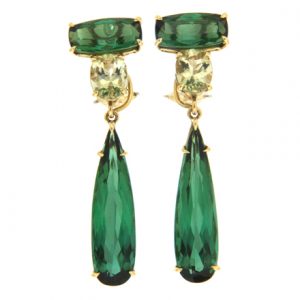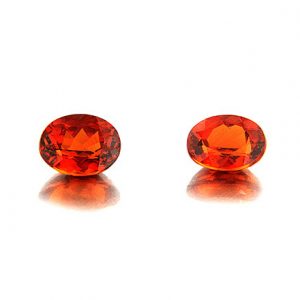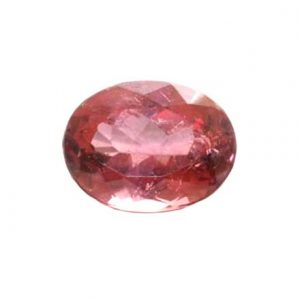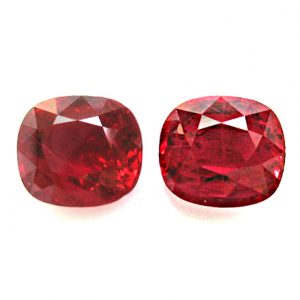Cut, color, clarity and carat, are also known as the 4Cs. While the concept of the 4Cs was developed as a global language to grade and evaluate diamonds, they also serve as a means to study colored gemstones. Due to the great variety in colored gems, it’s important to know how the 4Cs work beautifully in some jewels, but behave differently in others.
Knowing the 4Cs will help you gain a better understanding of the gemstones you adore. Jewels such as rubies and emeralds have specific hues and saturations that are especially valued and sought after. The type or number of clarity characteristics in a jewel may enhance or decrease its desirability, while cut can also affect a gemstone’s beauty. While there are stones such as amethyst that are plentiful in large sizes, some jewels are rare above a certain carat weight.
Carat
Carat is a unit of measurement that is used to determine size in gemstones. One metric carat is equivalent to one fifth of a gram, or 200 milligrams. Jewels are often measured to a one hundredth of a carat, or 0.01 carats. Due to the different chemical formulas, elements and density that make up different gemstones, jewels of two different species with the same cut and dimensions may have different carat weights.
While some gemstones such as topaz are available in a vast range of carat sizes, others are less common over a certain size, like tsavorite garnets larger than five carats. The environment in which some gemstones form, such as pegmatites, can allow for massive rough. In other circumstances, the heat and pressure that creates mineral jewels only allows for smaller stones to form. Due to rarity, the price per carat of less common large stones rises. With all other factors being equal, a one carat stone is more valuable than its half carat cousin.
Some gemstones are prized for colors that look their best in larger carats. Bigger crystals may have more intense hues, especially with stones that lean more towards pastel tones, like kunzite or aquamarine. A heftier carat weight for such jewels can help create an intense color sought after by connoisseurs.
Cut
Gemstones in their rough state display a wealth of shape and color. Alluvial stones, those found away from their place of origin, may take on hues resembling frosted glass and might sport the rounded forms of tumbled pebbles. Other rough may boast sharply defined habit denoting its underlying atomic structure, with columns, pyramids, star shapes and more. These stones may not have a uniform color throughout, but display a variety of tints.
Jewels are cut in order to bring out the greatest beauty possible. With a skilled gemstone cutter, a transparent stone brightened, with light reflecting off of its surface as well as from inside the crystal. The jewel’s color is optimized, with uniform hues when viewed from the top down, its tone and saturation as close to ideal as possible.
The shape of the rough usually influences the outline of the faceted stone. Tourmalines, which form as slender columns, are often cut into baguettes, emerald cuts and other elongated shapes. Flattened rough like some corundum samples may be transformed into faceted jewels with broad tops and bottoms.
Other factors which influence is cut include color zoning. If a gemstone is valued for pure blue and a rough has blue and blue-green portions, then the cutter will try to position the eventual jewel so that it comes from as much of the desired color as possible. In other circumstances, like ametrine or bicolor tourmaline, cutters try to make a finished jewel that shows each hue to their best advantage. If a rough stone is light in color and more intense hues are favored, cutters may shape the jewel so that it has a deep pavilion.
The clarity of a stone may impact how it is cut. Rough with a large number of fissures and multiple cleavage planes are better suited for some cuts than others. Heavily included stones may be used for carving into beads or cut into cabochons, a cut with a flat bottom and rounded top and sides. Those that appear strong enough to withstand faceting are cut in ways to reduce possible harm to the jewel, such as emeralds and rectangular step cuts.
Translucent and opaque stones reflect light differently from transparent stones. Since they don’t have much internal brilliance to bring out, they are cut into cabochons or carved into intaglios, cameos and other fanciful shapes. Jewel which exhibit light phenomena like opals and moonstones are also cut into cabochons in order to highlight their unusual qualities.
Clarity
Most gemstones bear traces of their birth, such as minute gas bubbles or healed fissures, which in turn affects their appearance. Some jewels display nothing but pure crystal, providing a viewer with an unbroken view of stone. Other gems bear flecks here and there that may affect the transparency or the passage of light through the jewel. This concept is referred to as clarity, and the quirks on and inside gemstones are known as clarity characteristics.
Clarity characteristics can be further divided into two categories, blemishes and inclusions. The former sit on the surface of a gemstone, like a scratch or polish lines. Inclusions are situated within the jewel, such as foreign crystals, pockets of fluid, or partially healed fractures. Depending on the jewel and the type of inclusion, gemologists are able to determine if a stone is natural or lab created, and where in the earth it formed.
While colored gemstones are rated for clarity, they’re held to different standards than diamonds. Rather than eleven designations, colored gemstones have three clarity types. Type I gemstones are eye clean, meaning that no clarity characteristics are visible to the naked eye. Jewels from this type are often sought after. Type II gemstones have visible inclusions that don’t detract from their durability or aesthetic appeal. Type III jewels have extensive clarity characteristics, often a result of their growth environment or mining conditions.
Some clarity characteristics may impact a jewel’s durability. Surface reaching fissures, for example, may make a gemstone vulnerable to breaking upon accidental impact. Cutters will try to reduce the risk to such stones by shaping them into cabochons or facet stones in ways which reduce the risk. Emeralds are often cut in ways to protect their durability while showcasing their clarity characteristics.
Depending on the gemstone, clarity characteristics are popular amongst connoisseurs. Amber containing plant or animal specimens are more valuable than eye clean pieces, especially if the item is large and well defined. Rutile, a needle shaped crystal, helps create asterism and chatoyancy and some jewels, while hollow spaces create similar effects in other gems.
Chatoyancy, or the cat’s eye effect, occurs when rutile or very thin negative spaces line up in a row within the gemstone. As light hits the jewel, a band of light appears perpendicular to the inclusions. Intersecting rows of rutile creates several lines of light, forming a star, one of the most admired clarity characteristics.
Color
Color is one of the first traits one notices when looking at a gemstone, and what makes jewels so desirable. Rubies are famed for being red, emeralds for their greens, and opals for their flashes of color.
Hue varies quite a bit. Even jewels of the same species, with the same trace elements and unearthed in the same location may have variations in color. To help understand this trait, here are a few terms.
“Body color” refers denotes whether a jewel is red, green, or another hue, how light or dark the stone is, and how intense the color. A number of factors influence a jewel’s body color, including the stone’s chemical formula, the presence of any trace elements and how the gem is cut. Some gems may have other hues in addition to its body color, and are given additional classifications.
Most gemstones are famed for having a specific shade or shades that are considered especially beautiful. More famous examples include pure blue for sapphires, and pure green to bluish green for emeralds. This is a jewel’s “fine color”. Demand for a gemstone’s fine color is higher than demand for other available hues, and tend to have a greater value. Gem cutters will try to fashion stones to achieve fine colors.
A stone’s “color range” denotes the available colors in a given gemstone. Color range may be narrow, like peridot’s yellow greens, to nearly every hue such as sapphire and tourmaline. While some hues in a color range may be more popular than others, many designers like to create jewelry that plays along the entire range, like suites of jewelry with blue, yellow and pink sapphires.
How Color Behaves in Gemstones
 Color in a gemstone is affected by many factors, including light. Unlike with pigment, white light is made of every hue on the visible spectrum. At its most basic, color occurs in a jewel when white light enters the stone. Certain hues are absorbed, while others are reflected to the eye, creating the red in rubies, the green in emeralds, and the colors of other gemstones. The exact hue that occurs in different jewels depends on its chemical formula, trace elements, cut, and other matters.
Color in a gemstone is affected by many factors, including light. Unlike with pigment, white light is made of every hue on the visible spectrum. At its most basic, color occurs in a jewel when white light enters the stone. Certain hues are absorbed, while others are reflected to the eye, creating the red in rubies, the green in emeralds, and the colors of other gemstones. The exact hue that occurs in different jewels depends on its chemical formula, trace elements, cut, and other matters.
Trace elements are elements not a part of a stone’s chemical formula that replace parts of the crystal structure. For example, if a stone is made up of a thousand molecules typically made of a-b-c-d, one or two may be a-b-x-d. These small differences are enough to change the color of a stone. Though aquamarine, morganite and emerald are all beryl, the presence of iron, manganese, chromium or vanadium in the crystal structure changes the color and identity of the gem.
Other jewels have color as an inherent part of its design, rather than from outside factors. Peridot and almandine garnets get their hues from the iron that’s part of their chemical formulas. Gems like these may have variation in tone or saturation, though the range of available hues are narrower than other stones. Such a jewel may be available in very slightly yellow green to yellow green, though pure yellow or green may be out of its purview.
Still more stones are influenced by color centers, tiny imperfections in the jewel’s atomic structure that causes the entire gem to interact with light differently, creating color. In order to unlock the full beauty of gemstones with color centers, they must be exposed to radiation, either natural or with human help. Radiation interacts with a stone’s subatomic particles, creating subtle action that brings about color. Maxixe beryl, a naturally occurring electric blue jewel, is a product of color centers. Irradiated gemstones are tested for safety before they’re allowed onto the market.
Color Change

Some gemstones have more than one hue. This may manifest as color zoning, as in the case of tourmaline and ametrine. In other instances, the elements inside a jewel’s crystal structure causes the stone to interact with light in an unusual way. Daylight will cause these gems to reflect one color, such as purple, while incandescent causes the jewel to reflect a different hue, like blue. This optical phenomenon is known as color change.
The most well-known and celebrated color change gemstone is alexandrite. In this jewel, traces of chromium reacts with light and the gem’s chemical formula in such a way that it’s equally capable of absorbing red and green. Exposure to light with large amounts of red in it, like sunlight, tips the balance to make alexandrite appear red. Light rich in blue or green turns the jewel green.
Other gemstones which exhibit color change include spinel, sapphire and garnet. Like alexandrite, their phenomenon is caused by trace elements, though the specific element may vary by gemstone type. The colors given off may also be different, such as blue and purple instead of green and red. Color change jewels are all influenced by the amount of colors in different white lights. As a whole, these gemstones are quite rare, with those that change into the intense hues especially sought after.
Color Zoning

The trace elements, color centers and other factors that determine a jewel’s hue aren’t always evenly distributed in the crystal. Depending on the conditions the stone was formed in, the color can vary. The rough gem may have patches of deeper saturation, lighter tones, or different hues all together. This trait is known as color zoning.
For jewels where uniform hue is preferred, gem cutters aim to shape stones that display the most of a desired color. If saturated hues are in demand, the cutter will try to make the finished stone have the more intense coloring. Should a client desire stones that are moderate in tone, then that’s what the cutter will try to shape. Cutters do what they can to make color zoning as inconspicuous as possible in the final jewel.
With gemstones like tourmaline and ametrine, color zoning is part of the jewel’s appeal. In these instances, gem cutters try to orient the finished jewels so that the contrast in hue is apparent. Common styles include cuts that are half one color and half another, or bands of different hues traveling down the length of the stone like stripes.
Color Aspects
Describing the color of a gemstone can be a tricky process. To call a jewel “blue” may not be enough to convey the appearance of a gem. Modifiers like “sky blue” or “ocean blue” may convey different mental images to different people, leading to a less than accurate idea of the stone. Terms like “Kashmir” or “Ceylon” blue may add romance to the jewel, but unless a stone comes from a certain location, there are rules against using a location as a descriptor. Organizations such as the Gemological Institute of America (GIA,) have come up with terms and concepts to help create a standardized way of describing color.
GIA uses the concepts of hue, tone and saturation to evaluate a jewel’s color. “Hue” is used to indicate the first impression one gets upon seeing a gem, such as red or yellow. “Tone” refers to how light or dark a gemstone is. Jewels with medium tones tend to be more in demand than ones that are very light or dark. “Saturation” is the intensity of a gemstone’s color. Depending on the stone, gems with low saturation tend to look grey or brown tinged, while high saturation may look dark or vivid.
GIA uses its Colored Stone Grading System to evaluate color, which includes a hue wheel. This circle is made of 31 sections, with each piece representing a color. Each hue is slightly different from its neighbor. From a distance, the wheel looks like a rainbow, with one color gradating into another. The circle is divided into broad categories like red, orange, yellow. The gradient hues are given names like orange Red, Red Orange, red Orange, etc. Capital letters denote which hue is dominant, with some hues sharing equal dominance.
Saturation and tone are measured on scales of 1-6 and 2-8 respectively. Saturation uses two ranges to determine intensity, with one for cool based colors like blue and the other for warm hues like orange. Cool and warm colors leave different impressions based upon saturation. The scales use 1 to denote greyish or brownish hues, based on the jewel’s coolness or warmth, and 6 as most vivid. One tone scale is used for all hues, with 2 being very light and 8 very dark.
How Gemstones Are Cut
All jewels begin as rough. Though the stone will be cleaned, polished and otherwise fashioned into a beautiful gem, the final result is usually influenced by its rough state. Long thin rough is often faceted into rectangles, fragile jewels like emeralds are cut in ways to promote durability, and opaque stones may be carved rather than faceted. All gemstones are cut to bring out their best attributes, and often to preserve carat weight.
Before rough is cut, it is sorted according to size, while heavily included material and traces of host rock are removed. Depending on how delicate the rough is, a small hammer or pliers may be used. After trimming, the cutter will examine the stone, searching for color zoning, possible cleavage planes, and other factors which may influence the appearance of the final product.
Depending on what the cutter decides, the rough may be left as is, or divided into smaller pieces. The stone is then prepared for faceting by a process called preforming. This step is highly influential to the final shape of the stone, and is handled by skilled cutters. To preform, the stone is fastened to a device called the dopstick, and shaped against a grinding or polishing wheel, called a lap.
The dopstick is usually attached to a faceting head, which helps to hold the stick and the jewel at the precise angles needed to give the stone its shape. Cutters must keep the nature of the jewel and its cleavage plane in mind. If a particular stone is improperly oriented on the dopstick, the stone might become damaged. Faceting heads are also able to hold dopsticks in place for longer and at a steadier rate than a human hand might.
After faceting, the gemstone is polished. This action smooths the surface of the gemstone as much as possible, and helps bring out the stone’s luster and color. Once polishing is complete, the gemstone may be cleaned to remove any traces of dust or liquids used to lubricate and cool the stone during the cutting process. With the gem faceted and shining, it’s ready to be set into jewelry.
Lighting and Stones

Without light, a jewel’s beauty cannot be seen. Light absorbs some colors, reflect others, and allows a gemstone to shine. The disruption of light allows people to see a ruby’s star, a moonstone’s adularescence, a pearl’s orient, and other features. Depending on the jewel, light can reflect off of an internal facet at different rates, giving the impression of two facets when there is actually one.
Common forms of light, such as sun, fluorescent and candle, have different effects on gemstones. Daylight, with more red wavelengths, may bring out warmer hues in a jewel, while fluorescent lights may make a stone cooler. Bright lights may play up a stone’s luster, and dimmer ones may make a jewel seem darker. A ruby may look richer in sunlight, while the blue of a sapphire may be more intense by incandescent. The same sapphire may look darker in the shade on a cloudy day, and brighter in direct sunlight. When a jeweler evaluates a gemstone, they try to do so in uniform conditions.
If a jeweler examines gemstones in a laboratory, they try to make sure that they use the same type of lights each time for consistency’s sake, with the preferred lighting being daylight equivalent fluorescents. Those that examine gems outdoors try to do so at the same time of day and the same location to reduce variables in how they grade stones. If neither is possible, jewelers bring master stones for comparison’s sake. In these ways, it’s easier to determine hue, tone and saturation in a gem with fewer chances for errors. In an unfamiliar environment, it may be harder to notice subtle color differences.
Some jewels look pretty under bright lights, giving stones a chance to display their colors and reflective qualities. Other gemstones lack the stability to withstand strong lighting, and may fade over time. They may be referred to as candlelight gems, jewel that are well suited to evening events and are best stored in opaque boxes. Kunzite is one of the best known of these gems.
Extinction and Windows
Sometimes, when a rough gemstone is a wide flat piece, a jewel cutter will shape it into a faceted stone, preserving more carat weight than trimming it into a smaller, proportional jewel. Light may leak through the bottoms of these gemstones, while the light that’s reflected back to the eye doesn’t have as far to travel through the stone, creating a less saturated jewel. This type of cut is known as a window.
A distinctive feature of windows is their shallowness, which leads to a number of effects on its color and lighting. The way light travels through the jewel to another, the width of the table and culet and the shallowness of the pavilion make many things are visible through the jewel. Text may be readable through the stone.
Windowed cuts are used to make the most of rough that is highly valued. If larger carat sizes are uncommon and more in demand, then trimming most of a rough away to create a smaller jewel with a deeper pavilion is a loss of potential. For smaller, flatter pieces of rough, windowed stones allow for faceted jewels to be made, rather than overlooked.
The cut is also employed when a rough gemstone is exceptionally dark. A jewel’s beauty thrives on balance. If the tone is too light or dark, it’s hard to appreciate the color. For these stones, a window cut helps to bring out their hue, lowering the intensity of the tone.
Some jewels receive very deep pavilions. Instead of light reflecting off of the inside of the stone and returning out through the top, they exit through the side of the pavilion, creating dark spots in the stone. These shadows are known as extinction.
Extinction style cuts are sometimes used as a way to preserve a stone. If the rough has an unusual shape, it may be better to follow the lines of the stone than to sacrifice carat in order for it to fit into more standard proportions. Especially valuable stones also benefit from weight retention.
Gemstones that tend to be very light, like kunzite and varieties of amethyst, benefit from deep pavilions and the resulting dark spots. Extinction deepens the tone of these jewels, bringing them closer to desired, harder to find colors. Jewels that have patches of different colors like blue and slightly bluish green also benefit from deeper pavilions, as extinction helps to disguise unintended color zoning.





